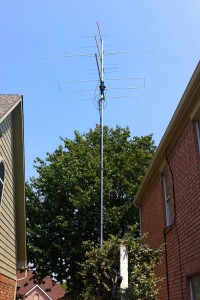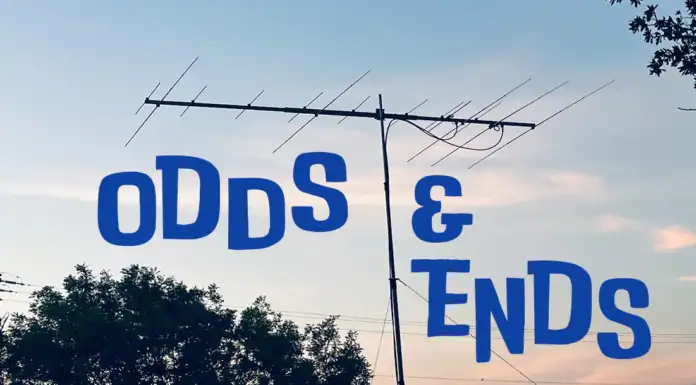I learned about cheap yagis for the first time at the Central States VHF Society’s 2014 Conference. I attended VHF 101 put on by Marshall Williams, K5QE, and Kent Britain, WA5VJB. During their session, they had several of the students put together 440 MHz yagis.
You can learn all about them at Cheap Yagi Antennas for VHF/UHF. This link will take you to Kent’s paper that’s been edited by John Maca, AB5SS.
My Antenna Parameters
 You may have read my previous post on the InnovAntennas 6 meter 3-element LFA Yagi. The reason I selected this antenna was that it just barely fit into my side yard, where I’ve positioned a push-up mast.
You may have read my previous post on the InnovAntennas 6 meter 3-element LFA Yagi. The reason I selected this antenna was that it just barely fit into my side yard, where I’ve positioned a push-up mast.
Within that size restriction, I needed to fit antennas for 2 meters and 70 centimeters to get me on those two bands for runs at VHF contest entries in the single operator 3 band category.
At first I looked at the InnovAntennas options along with a few others. However, they are fairly costly. Plus, I didn’t want to put them up and when I move in a couple of years find that I can replace them with longer antennas with more gain. Or, perhaps by that time I’ll move on to anther amateur radio adventure.
Thus, entered the option for the cheap yagis.
My Cheap Yagis
In working with Kent’s paper, I found that the five element 2 meter yagi would fit nicely as would the eleven element 70 centimeter version. I used slightly larger wood booms, the 0.75″ x 1.5″ select pine available at the nearby Lowe’s Hardware. I also used #8 solid copper wire throughout as it was readily available. There are cheaper ways, but 25 feet was just $10. I also found some antenna mounts online at eBay that worked perfectly (called u-bolt nesting assembly, a pair for $7). You can find cheaper options at Lowe’s or Home Depot but they don’t have the nesting part that fits to mast.
 For cabling, I used Davis RF Bury Flex for the run from the rig to just below the rotator. From there I used LMR-240 Ultra Flex. My big learning experience was using N type connectors for the 70 cm cabling. Again, I found some options on eBay that worked quite well, two-piece solder versions.
For cabling, I used Davis RF Bury Flex for the run from the rig to just below the rotator. From there I used LMR-240 Ultra Flex. My big learning experience was using N type connectors for the 70 cm cabling. Again, I found some options on eBay that worked quite well, two-piece solder versions.
One slight challenge was soldering the cable to the driven element. The copper wire works fine but the size requires considerable heat. I used a propane torch, you can see some torch marks on the boom… I also used super glue to secure the elements into the holes in the wooden boom. The boom is painted with a few coats of a hardwood deck finish that I had in the paint locker.
The mast is a six-foot steel fence post at 1.62″ in diameter. It worked perfectly for the rotator and all three antennas. In fact, this was the maximum size that would fit the u-bolts for the cheap yagis. It’s also pretty lightweight. I wouldn’t want to go longer on this set up. Installation was a bit challenged as I really needed a spotter, or a few more hands. But I got it into the air – and it should stay there.
I did look at stacking guidelines using the Bill Seabreeze, W3IY, application note. But basically found that the spacing is what I can do in the space I’ve got. The setup is closer to that of a rover installation, given all the various restrictions, particularly the pushup mast. But it works well.
Performance
 Testing for SWR using my new Redot VHF/UHF meter shows below 2 to 1 for both antennas. I would like to tweak the resonant point for the 2 meter antenna, but that would prove challenging to haul the thing down. So I’ll wait until I’m more ambitious. I also need to clean up the cabling and get some lightning arresters installed.
Testing for SWR using my new Redot VHF/UHF meter shows below 2 to 1 for both antennas. I would like to tweak the resonant point for the 2 meter antenna, but that would prove challenging to haul the thing down. So I’ll wait until I’m more ambitious. I also need to clean up the cabling and get some lightning arresters installed.
In early testing on 70 cm I’ve managed to pick up the K5RMG beacon in Austin at 188 miles. For 2 meters, attending the Sidewinders on Two net last night I managed to pick up most of those that checked in across Texas and Oklahoma. I’ve also tried the antennas on a few satellite passes. While I haven’t worked any of the birds yet, I can pick up the signals at this point.
I recommend these antennas for some fun on VHF/UHF and higher. They get the job done and do so at very low-cost. We’ll see how they do during the upcoming ARRL September VHF Contest.







[…] Nearly all the signals were booming in with just a few somewhat weak. Not bad either for my WA5JVB cheap yagis at 25 […]
[…] updated my antennas, replacing the cheap yagis with Diamond 2m and 70cm yagis, primarily for satellite work. In the process, I’ve taken down […]
[…] in July 2016, I replaced the Cheap Yagis and the 3-element LFA. I put up Diamond antennas for working satellites and returned the Stressed […]
[…] to log close to 150 QSOs and almost 100 grids. I’ve done this with my IC-910H and either my cheap yagis or more recently with the Diamond yagis arranged specifically for satellite contacts. So […]
[…] Cheap Yagis — this is an overview of building, installing, and operating with cheap yagis on 2 meters and 70 centimeters. […]
[…] Cheap Yagis for VHF and UHF. […]